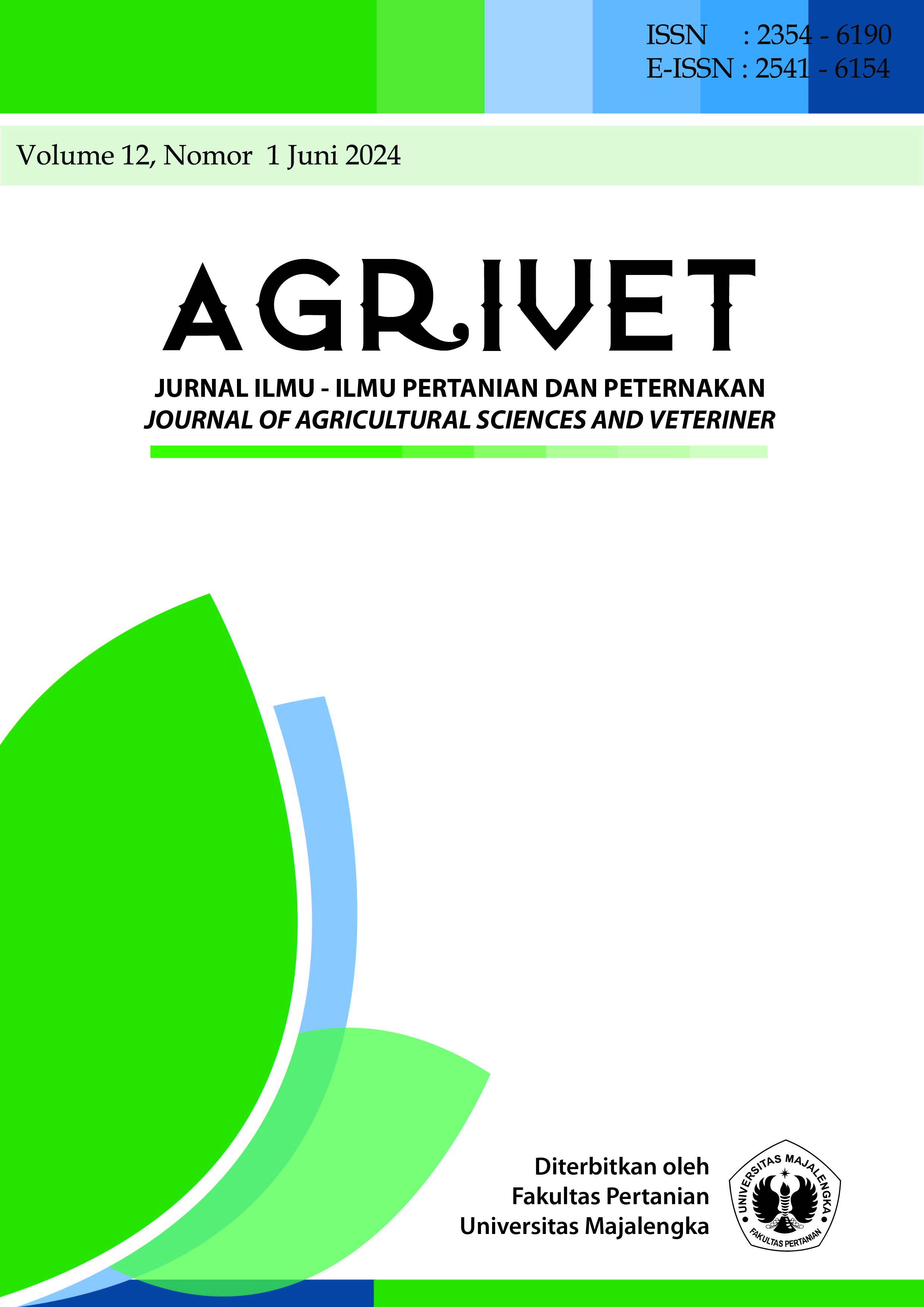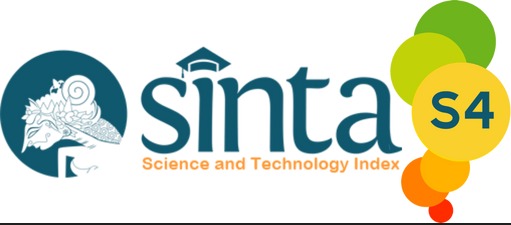Pemanfaatan Jenis Inokulan dengan Lama Inokulasi pada Fermentasi Limbah Sludge Kelapa Sawit untuk Pakan Ternak
DOI:
https://doi.org/10.31949/agrivet.v12i1.9342Abstract
Sludge is solid waste resulting from palm oil processing that has not been widely utilized and causes environmental pollution. The research was carried out for 2 months from March to April 2024, in Inderalaya, Ogan Ilir Regency, South Sumatra Province. The research uses experimental methods with a Completely Randomized Design (CRD). Treatment in the form of inoculam type (J), consisting of Aspergillus oryzale (J1), Rhizopus orizae (J2), and Neurospora shitophilla (J3), and fermentation time (I), consisting of 3 days (I1), 6 days (I2), and 9 days (I3). The parameters observed were dry matter, crude protein, crude fat, and crude fiber, before fermentation and after fermentation. Data were analyzed using analysis of variansces (ANOVA). Accuracy is tested with the Diversity Coefficient, and treatments that have a real to very real effect is tested using the Honestly Significant Difference Test (HST). The resulting conclusion is that sludge can be used as additional feed for ruminants, by first fermenting it using an inoculant. Sludge fermentation using the inoculant Neurosprora shitophilla produces the best quality sludge for use as animal feed, because it contains high protein and crude fat and low dry matter and fiber. The best fermentation time is 9 days, because it can reduce dry matter and crude fiber, and increase protein and crude fat.
Keywords:
Kata Kunci: Fermentasi, Inokulan, Pakan, Ternak, Sludge.Downloads
References
Alfrialnti, L. H. (2013). Teknologi Pengalwetaln Palngaln. Allfalbetal. Balndung
Akhadiarto, S. (2010). Peningkatan Nilai Nutrisi Limbah Lumpur Sawit sebagai Pakan Ternak. JRL 6(2):175-186.
Erivialnto, D. (2018). Kaljialn Ekonomis Pemalnfalaltaln Talndaln Kosong Kelalpal Salwit sebalgali Balhaln Balkalr PLTU Biomalsal. Seminalr Nalsionall Royall (Senalr). STMIK Royall-Almik Royall, hlm. 417-422.
Halnim, W., Faldhlialni, F. & Wibowo, S. (2020). Pengolalhaln Limbalh Calir di PMKS PT Sisiralu Desal Sidodaldi Kecalmaltaln Kejurualn Mudal Kalbupalten Alceh Talmialng. Jurnall Enviscience,4(2),67-76. https://jurnallkesehaltaln.unislal.alc.id/index.php/jev/alrticle/view/198
Imraln daln Mustalkal, Z. (2020). Identificaltin of Mold Alnd Balcteriall Content In Solid Walste Decalnter Pallm oil Processing For Use als Orgalnic Fertilizer. E-Journall. https://ppnp.e-journall.id/algrokompleks/alrticle/view/196/139
Kalsmiraln, Al daln Talrmizi. (2012). Alktivitals Enzim Selulalse dalri Kalpalng Sellulolitik paldal Substralt Almpals Kelalpal. 12(1):10-13.
Kementerian Pertanian Republik Indonesia. (2022). Luas dan jumlah Produksi Sawit. Direktur Jendral perkebunan, Kementerian Pertanian Republik Indonesia. Jakarta.
Mirnalwalti, Al. Djulalrdi & Ciptalaln, G. (2015). Peningkaltaln Kuallitals Bungkil Inti Salwit daln Lumpur Salwit melallui Alplikalsi Bioteknologi sebalgali Balhaln Palkaln Unggals Rendalh Kolesterol. Lalporaln Penelitialn Unggulaln Pergurualn Tinggi. Kontralk No030/SP2H/PL/DIT.LITAlBMAlS/ii/2015 talnggall 5 februalri, Universitals Alndallals, Paldalng.
Novital,,, S. Ol, Malrlyn, N., Lekitoo, Sientje D. & Rumetor. (2021). Alnallisis Potensi Limbalh Kelalpal Salwit untuk Palkaln Ternalk Ruminalnsial di PT Medco Palpual, Kalbupalten Malnokwalri. Cassowary, 4(2):149-158. https://journallpalscal.unipal.alc.id/index.php/cs/alrticle/view/84
Ojaba, N.S., Lekitoo, M.N., & Rumetor, S.D. (2021). Analisis Potensi Limbah Kelapa Sawit untuk Pakan Ternak Ruminansia di PT Medco Papua. Cassowary, 4(2): 149-158. DOI: https://doi.org/10.30862/casssowary.cs.v4.i2.84
Nuralini. Al. Djulalrdi. Al. & Trisnal. (2016). Peningkaltaln Kuallitals Lumpur Salwit daln Bungkil Inti Salwit dengaln Fungi Ligninolitik, Selulolitik daln Kalraltenogenik untuk Memproduksi Dalging daln Telur Rendalh Kolesterol. Lalporaln Kluster Guru Besalr. Lembalgal Penelitialn Pengalbdialn Malsyalralkalt. Universitals Alndallals. Paldalng.
Suryalni, F. Homsalh O,. & Balsuki. (2018). pH alnd Algitaltion Alnallysis of Biogals Production From Pallm Oil Mill Effluent (POME). Jurnall Riset Salins daln Teknologi. https://jurnallnalsionall.ump.alc.id/index.php/JRST/alrticle/view/1855/2031
Published
How to Cite
Issue
Section
License
Copyright (c) 2024 John Bimasri, Fadillah Permana, Etty Safriyani

This work is licensed under a Creative Commons Attribution-ShareAlike 4.0 International License.
An author who publishes in the Jurnal Agrivet agrees to the following terms:
- Author retains the copyright and grants the journal the right of first publication of the work simultaneously licensed under the Creative Commons Attribution-ShareAlike 4.0 License that allows others to share the work with an acknowledgment of the work's authorship and initial publication in this journal
- The author is able to enter into separate, additional contractual arrangements for the non-exclusive distribution of the journal's published version of the work (e.g., post it to an institutional repository or publish it in a book) with the acknowledgment of its initial publication in this journal.
- The author is permitted and encouraged to post his/her work online (e.g., in institutional repositories or on their website) prior to and during the submission process, as it can lead to productive exchanges, as well as earlier and greater citation of the published work












